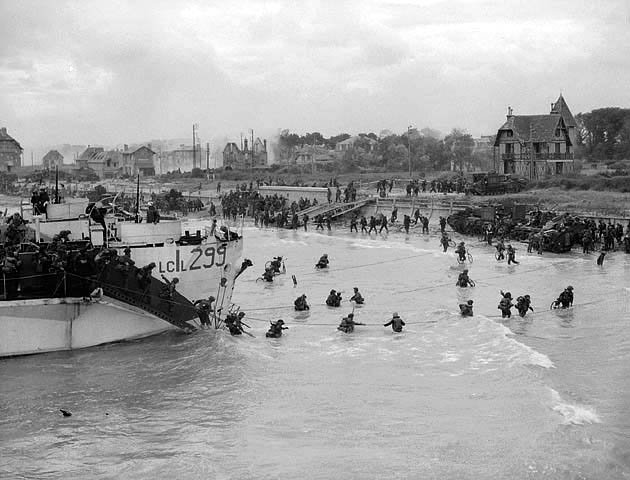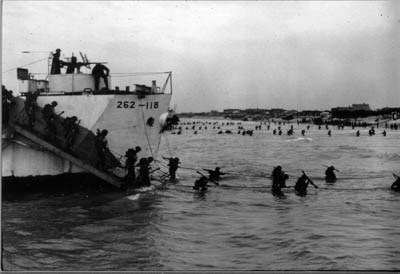

The 9th Brigade consisting of the Highland Light Infantry, Stormont Dundas and Glengarry Highlanders, and North Nova Scotia Highlanders regiments landed later in the morning. The Sherbrooke Fusiliers tanks (27th Armoured Regiment) provided tank support to the brigade.
At 10:50 a.m. Divisional Headquarters ordered the 9th Brigade to land. The preferred plan was to land the 9th Brigade at St.Aubin and Bernières and alternatively Courseulles. Then the 9th Brigade would pass through the lead brigade and head to the divisional objective, the high ground around Carpiquet airport. Based on the information General Rod Keller had received, he made the decision to land the 9th Brigade at St.Aubin and Bernières. He did not know at the time the Navy had closed Nan red beach at St. Aubin because of the enemy gun still in action there. The entire brigade was forced to land at Bernières and the resulting traffic jam on the one road leading to Beny-sur-Mer caused a critical delay for the 9th Brigade's advance.

9th Canadian Infantry Brigade disembark landing craft at Bernières-sur-Mer.
The North Nova Scotia Highlanders, commanded by Lt.-Col. C. Petch, landed at 11:40 a.m. The narrow beach was already packed with troops from 8th Brigade. The narrow streets were jammed with impatient troops, bicycles, vehicles and tanks. At 12:05 Brigade Headquarters reported, "Beaches crowded, standing off waiting to land"; but fifteen minutes later it signalled that the brigade commander had landed and the units were moving to their assembly area near Beny.
The severe congestion around Bernières slowed the movement and the battalions halted on the outskirts of the village. The North Nova Scotia Highlanders who were in the lead, did not move on towards Beny until 4:05 p.m. They were accompanied by the 27th Armoured Regiment (The Sherbrooke Fusiliers Regiment), commanded by Lt.-Col. M. B. K. Gordon, and were followed by the other battalions of the brigade, The Stormont, Dundas and Glengarry Highlanders (Lt.-Col. G. H. Christiansen) and The Highland Light Infantry of Canada (Lt.-Col. F. M. Griffiths).

9th Canadian Infantry Brigade disembark landing craft at Bernières-sur-Mer.
At 6:20 p.m. the North Nova Scotias and the Sherbrooke Fusiliers Regiment tanks, acting as the brigade's advanced guard, moved off from the assembly area at Beny to pass through the Queen's Own and the Chaudière and carry the advance southward. Three companies of the Highlanders rode on the Sherbrookes' tanks. Machine-gun fire held up the advance along the way and in the vicinity of Colomby-sur-Thaon 'A' Company met opposition which caused further delay. The North Nova Scotia's reached Villons-les-Buissons by 2000 hours and ran into more German resistance. It was now evident that the advanced guard units could not reach their objective in the Carpiquet area before dark. They received the order to halt and begin digging in. The infantry and tanks accordingly formed a fortress in the area Anisy-Villons-les-Buissons. The brigade's other battalions were still in the assembly area at Beny.
They were less then 4 miles from Carpiquet airfield, the final divisional
objective. But with the rest of the brigade strung out on the road from
Beny, and the fear of a counter attack from either the 12th SS Panzer
or 21st Panzer division, it was decided to secure their positions and
the bridgehead.
